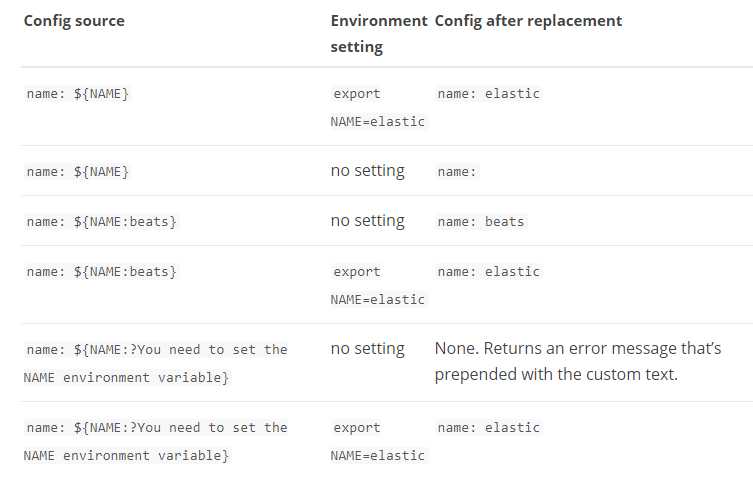配置文件格式(三)
阿新 • • 發佈:2019-02-28
match index 完整路徑 建議 時間 cse with disabled 拼接 一、YAML格式簡介
Beats的配置文件基於YAML,這種文件格式比XML和JSON等常用的數據格式更容易讀寫。在Beats中所有的YAML文件都以字典開始,一個無序的鍵值對。除了字典,YAML還支持列表、數值、字符串和其他的數據類型。相同列表或字典的所有成員必須有相同的縮進級別。
1、字典由具有相同縮進級別的key:value組成,冒號後面必須有一個空格3 1
2、列表由“-”表示,所有的列表成員在相同縮進級別由“-”開始
3、beats中使用列表和字典來構建結構化配置8 1
4、列表和字典也可以用縮寫的方式表示,縮寫方式有點類似於JSON格式,字典使用{},列表使用[]2 1
二、Namespacing
1、所有的設置都使用字典和列表。讀取配置文件時,通過使用設置名稱及其父結構的名稱的完整路徑,這些設置將被壓縮到名稱設置中。
2、列表創建的時候以0開始
不僅可以以縮進的方式,也可以以折疊的方式
三、配置文件的數據類型
配置文件中的設置的值將被轉換為beats所需的值,如果設置的值的類型不是配置文件所要求的值類型,那麽啟動將會報錯。
1、Boolean1 1
2、Number1 1
3、String在YAML中,字符串支持多種格式,雙引號(“ ”)、單引號(’ ‘)、無引號()
4、Duration 時間必須帶有單位,如ns, us, ms, s, m, h1 1
5、正則表達式因為在YAML和正則表達式中使用"\"進行字符串的轉義,因此建議在使用正則表達式的時候使用單引號字符串,當使用單引號字符串的時候\不會被轉義
6、格式串(打印的格式)1 1
四、環境變量1、可以在配置文件中引用環境變量,設置為在運行期間需要用到的值;如1 1
2、當啟動時,變量的值將會被環境變量的值替換。除非指定默認值或自定義錯誤文本,否則會被當做空字符串處理指定默認值:1 1
指定自定義錯誤文本1 1
例子:
4、在環境變量中指定復雜的變量可以使用類似JSON的語法使用復雜的變量,如字典、列表;如:1 1
五、引用變量
1、Beats中設置可以引用其他設置,將多個可選的自定義值拼接到新值中,如Filebeat默認的註冊表文件為:1 1
2、如es.host1 1
3、普通的引用,沒有默認的值,沒有拼接,通過其他字符串來引用完整的命名空間,如:
1 1
六、命令行參數
使用-c指定配置文件,如果不指定則使用默認的配置文件;可以通過在啟動時使用-E指定配置文件

如:配置文件裏的配置如下:1 1
如果在啟動的時候,加上1 1
那麽配置文件相當於: 1
官方文檔:https://www.elastic.co/guide/en/beats/libbeat/6.6/config-file-format.html
Beats的配置文件基於YAML,這種文件格式比XML和JSON等常用的數據格式更容易讀寫。在Beats中所有的YAML文件都以字典開始,一個無序的鍵值對。除了字典,YAML還支持列表、數值、字符串和其他的數據類型。相同列表或字典的所有成員必須有相同的縮進級別。
1、字典由具有相同縮進級別的key:value組成,冒號後面必須有一個空格3 1
name: John Doe2age: 343country: Canada2、列表由“-”表示,所有的列表成員在相同縮進級別由“-”開始
- Red2- Green3- Blue3、beats中使用列表和字典來構建結構化配置8 1
filebeat:2 inputs:3 - type: log4 paths:5 - /var/log/*.log6 multiline:7 pattern: ‘^[‘8 match: after 4、列表和字典也可以用縮寫的方式表示,縮寫方式有點類似於JSON格式,字典使用{},列表使用[]2 1
person: {name: "John Doe", age: 34, country: "Canada"}2colors: ["Red", "Green", "Blue"]二、Namespacing
1、所有的設置都使用字典和列表。讀取配置文件時,通過使用設置名稱及其父結構的名稱的完整路徑,這些設置將被壓縮到名稱設置中。
output:2 elasticsearch:3 index: ‘beat-%{[beat.version]}-%{+yyyy.MM.dd}‘將被壓縮成: output.elasticsearch.index: ‘beat-%{[beat.version]}-%{+yyyy.MM.dd}‘ 全名涉及到所有的父級結構2、列表創建的時候以0開始
x1
filebeat:2 inputs:3 - type: log將被壓縮為:filebeat.inputs.0.type: log不僅可以以縮進的方式,也可以以折疊的方式
三、配置文件的數據類型
配置文件中的設置的值將被轉換為beats所需的值,如果設置的值的類型不是配置文件所要求的值類型,那麽啟動將會報錯。
1、Boolean1 1
enabled: true2disabled: false2、Number1 1
integer: 1232negative: -13float: 5.43、String在YAML中,字符串支持多種格式,雙引號(“ ”)、單引號(’ ‘)、無引號()
4、Duration 時間必須帶有單位,如ns, us, ms, s, m, h1 1
duration1: 2.5s2duration2: 6h3duration_disabled: -1s5、正則表達式因為在YAML和正則表達式中使用"\"進行字符串的轉義,因此建議在使用正則表達式的時候使用單引號字符串,當使用單引號字符串的時候\不會被轉義
6、格式串(打印的格式)1 1
constant-format-string: ‘constant string‘2field-format-string: ‘%{[fieldname]} string‘3format-string-with-date: ‘%{[fieldname]}-%{+yyyy.MM.dd}‘四、環境變量1、可以在配置文件中引用環境變量,設置為在運行期間需要用到的值;如1 1
${VAR}var是環境變量的名稱2、當啟動時,變量的值將會被環境變量的值替換。除非指定默認值或自定義錯誤文本,否則會被當做空字符串處理指定默認值:1 1
${VAR:default_value}指定自定義錯誤文本1 1
${VAR:?error_text}例子:

4、在環境變量中指定復雜的變量可以使用類似JSON的語法使用復雜的變量,如字典、列表;如:1 1
ES_HOSTS="10.45.3.2:9220,10.45.3.1:9230"1 1output.elasticsearch:2 hosts: ‘${ES_HOSTS}‘五、引用變量
1、Beats中設置可以引用其他設置,將多個可選的自定義值拼接到新值中,如Filebeat默認的註冊表文件為:1 1
filebeat.registry: ${path.data}/registrypath.data是隱式設置的,可以在命令行重寫,也可以在配置文件重寫2、如es.host1 1
es.host: ‘${ES_HOST:localhost}‘2output.elasticsearch:4 hosts: [‘http://${es.host}:9200‘]3、普通的引用,沒有默認的值,沒有拼接,通過其他字符串來引用完整的命名空間,如:
1 1
namespace1:2 subnamespace:3 host: localhost4 sleep: 1s5namespace2:7 subnamespace:8 host: localhost9 sleep: 1s可以重寫為:1 1namespace1: ${shared}2namespace2: ${shared}3shared:5 subnamespace:6 host: localhost7 sleep: 1s六、命令行參數
使用-c指定配置文件,如果不指定則使用默認的配置文件;可以通過在啟動時使用-E指定配置文件

如:配置文件裏的配置如下:1 1
output.elasticsearch:2 hosts: ["http://localhost:9200"]3 username: username4 password: password如果在啟動的時候,加上1 1
-E output=‘{elasticsearch.enabled: false, console.pretty: true}‘那麽配置文件相當於: 1
output.elasticsearch:2 enabled: false3 hosts: ["http://localhost:9200"]4 username: username5 password: password6output.console:8 pretty: true官方文檔:https://www.elastic.co/guide/en/beats/libbeat/6.6/config-file-format.html
配置文件格式(三)
